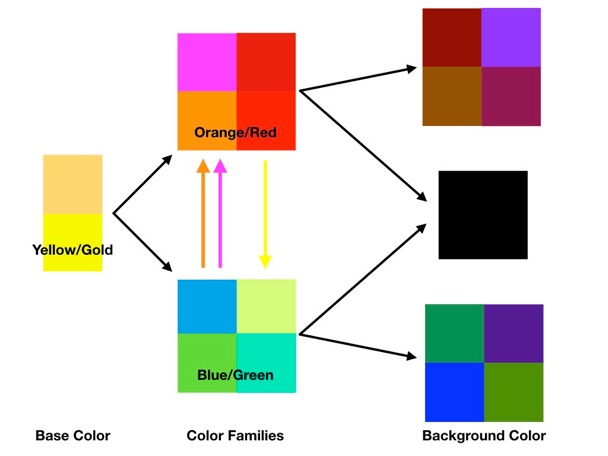Orange Rinse

There are many methods of dye removal. The orange rinse is one of the simplest and easiest to do. It is not an ancient Ukrainian technique, as those all utilized natural dyes and allowed much different color sequences than modern acid/aniline dyes do. No, it is the result of a quirk in the production of one brand of American pysanka dye.
What is a “Orange Rinse”? It is simply a jar of UGS Orange set aside for that purpose, nothing more.
Why is such a rinse even necessary? Because some designs call for colors from more than one color family, and often there is no way to sequence them properly. There are three color families of dyes: yellows/golds, blues/greens and reds/oranges/pinks/purples. When crafting a dyeing sequence, the yellow or gold color will generally be your base color, and then will be followed by progressively darker colors from another color family (which will cover the yellow or gold color well).
If you wish to incorporate colors from both both color families into your design, you need a way to switch from one to another. If there is only to be a very small amount of green, blue, pink or purple, these colors can be applied by spot-dyeing. If there will be large areas of a non-sequence color, then an orange rise may be one way of allowing it.
The orange rinse allows you to move from the Blue/Green family of dyes to the Orange/Red family of dyes. The Orange arrow between the two denotes the Orange rinse.

UGS dyes have two available orange colors: traditional orange and pumpkin. The traditional orange dye has a chemical formula which causes it to turn into a gel if vinegar is added, so it is mixed up without vinegar. The resulting dye is not as bright as other oranges, but it can be a lovely color none-the-less. And, because of the lack of vinegar in the solution, it is able to remove greens and blues from an eggshell.
Using the orange rinse is simple and straightforward: After applying wax to the yellow (or gold) egg, dye it light blue or light green, as called for by the pattern. (If using both, light blue should go first. Light blue does not work well over gold; use yellow instead.) Apply wax. Then put the egg into the orange rinse, and leave it in until the shell is a nice, even orange. This may take a while, and you may wish to change the egg’s position once or twice to ensure even dyeing.
Once the egg is orange, you can proceed using pinks/reds/purples, as called for by your pattern.
While the orange dye does a good job of removing blue or green, it gets quite dirty/muddy in the process. Initially, this does not affect the color much, but, when enough blue and green has been removed, the eggs will dye a muddy orange color. That is why, if you are going to use orange to rinse your eggs, you should keep a second jar of dye around just for this purpose, and label it as your “Orange Rinse.” I usually use an older jar of orange for this.
Note: If an egg is going to have orange color on it as part of the design, it is best to dye it in a jar of “clean” orange after doing an orange rinse.
Once your jar gets very muddy, replace it with a new jar of orange dye. The old dye can be tossed or used as a rust colored dye.
Sequences:
Yellow––> Light Blue––> Light Green––> Orange Rinse––> Orange––> Scarlet/Red/Pink
Gold––> Light Green––> Orange Rinse––> Orange––> Scarlet/Red/Pink
The orange rinse should work well to remove any non-red/orange dyes –– blues, greens, turquoise, purples, browns, etc. I use it most often to remove light blue and green, so these are the examples I give in my sequences. Removing darker colors can muddy your rinse quite a bit, though.
If I am going to do a yellow rinse (to get an egg back to yellow), I will usually do an orange rinse first, as it is quick and gets me halfway to my desired color. For example:
Red––> Orange Rinse––> Yellow Rinse––> Light Green
NB: The orange rinse ONLY works with vinegar-free orange dyes. I have always used UGS dye for this purpose, but EggCessories now offers an “Orange Cleansing” egg dye which should work equally well.
Back to Main Dyeing page
Back to Main Advanced Dyeing page
Back to Main Pysankarstvo page
Search my site with Google
Removing unwanted colors




